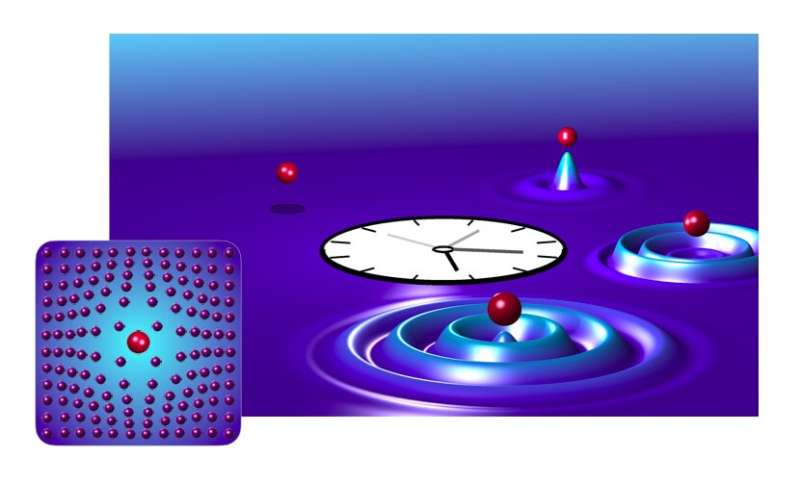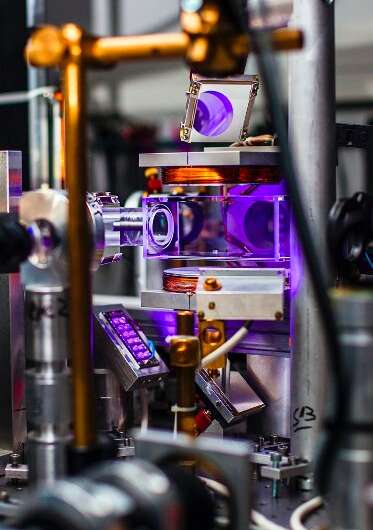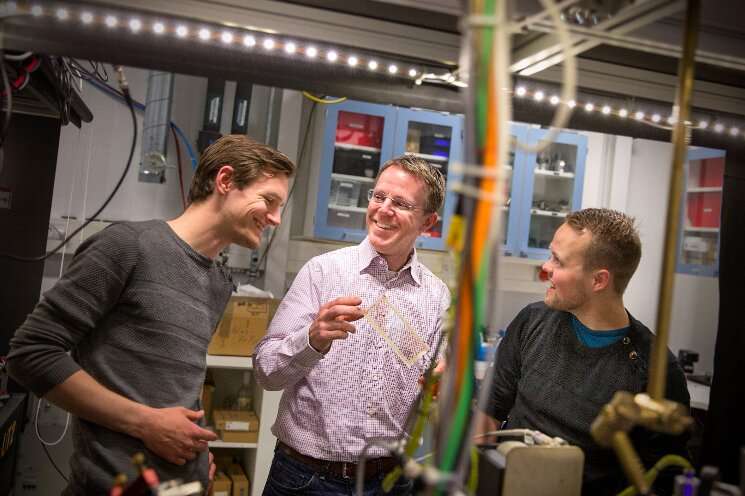March 11, 2021 feature
Observing the birth of a quasiparticle

Over the past decades, physicists worldwide have been trying to gain a better understanding of non-equilibrium dynamics in quantum many-body systems. Some studies investigated what are known as quasiparticles, disturbances or entities in physical systems that exhibit behavior similar to that of particles.
Researchers at Aarhus University recently carried out a study investigating the non-equilibrium dynamics of a quantum impurity immersed in a bosonic environment. Their paper, published in Nature Physics, sheds light on the dynamical behavior of interacting many-body systems, while also improving the current understanding of how Bose polarons are formed.
"Our recent article is part of an extensive investigation of so-called quasiparticles and is the culmination of a fruitful collaboration between experimental and theoretical physicists at Aarhus University," Magnus G. Skou, one of the researchers who carried out the study, told Phys.org. "Quasiparticles are extremely interesting, since they may consist of countless particles and their excitations."
The idea of quasiparticles was first introduced in the 1930s by physicist Lev Landau, who was trying to gain a better understanding of complex quantum systems. The experiments carried out by Skou and his colleagues build on models created by Landau.
In their studies, the researchers prepared coherent superposition states of atoms in a Bose-Einstein condensate with a small impurity-state component using an interferometric technique. Subsequently, they monitored the evolution of these quantum superpositions and their transition into polaronic quasiparticles.

Remarkably, the researchers were able to observe the birth of a unique class of quasiparticles, called Bose polarons, for the very first time. While in the past several research groups detected signs of these quasiparticles in laboratory settings, so far observing their gradual formation over time proved highly challenging, mainly because the processes through which they are formed are exceedingly fast.
"We studied how impurities interact with a pure medium and transform into Bose polarons," Skou explained. "Our experiments were performed using a medium of atoms cooled down to a stunningly low temperature of only a billionth degree above absolute zero, which is far below the temperature of outer space."
Using a gas of ultracold atoms, Skou and his colleagues were able to study quantum impurities in extremely pure and well-controlled environments. These impurities were created by transferring a few of the medium atoms into a special impurity quantum state, using an ultrafast radio-frequency pulse of only 0.5µs.
"We found that the impurities began to dynamically interact with the atoms of the medium and we measured this evolution using another short radio-frequency pulse," Skou said. "This two-pulse scheme made it possible for us to observe the eventual quasiparticle formation of the polaron."

In their experiments, Skou and his colleagues observed three distinct regimes of impurity evolution marked by dynamic transitions. These regimes then link initial few-body and later many-body physical dynamics.
"Our study is a big step forward in understanding Bose polarons, their non-equilibrium dynamics and how they are formed," Skou said. "These quantum phenomena are exceedingly fascinating by themselves, but they are furthermore conjectured to be key elements in exotic technologies such as organic semiconductors and superconductors."
In the future, the findings gathered by Skou and his colleagues could open up new possibilities for studying non-equilibrium quantum phenomena, which could in turn inform the development of new semiconductor and superconductor-based technologies. In their next studies, the researchers also plan to investigate the ways in which polarons interact with each other.
"These interactions have been theoretically predicted in 2018 to enable two polarons to bind to each other, which generates an entire new quasiparticle known as a Bose bipolaron," Skou said. "This adds a completely new layer of exciting but complex quantum physics. Though this quasiparticle has not been seen in an ultracold gas yet, we believe our experiment may hold potential for observing its existence."
More information: Non-equilibrium quantum dynamics and formation of the Bose polaron. Nature Physics(2021). DOI: 10.1038/s41567-021-01184-5.
Bipolarons in a Bose-Einstein condensate. Physical Review Letters(2018).
DOI: 10.1103/PhysRevLett.121.013401.
Observation of attractive and repulsive polarons in a Bose-Einstein condensate. Physical Review Letters(2016). DOI: 10.1103/PhysRevLett.117.055302.
Bose polarons in the strongly interacting regime. Physical Review Letters(2016). DOI: 10.1103/PhysRevLett.117.055301.
Bose polarons near quantum criticality. Science(2020). DOI: 10.1126/science.aax5850.
Journal information: Nature Physics , Physical Review Letters , Science
© 2021 Science X Network





















